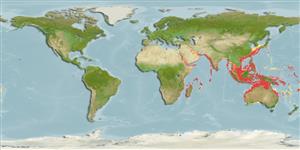Common names from other countries
Issue
Species spelling Eschmeyer, pers. comm.
Environment: milieu / climate zone / depth range / distribution range
Ecologie
marien rifbewoner; diepte 7 - 200 m (Ref. 11298). Tropical
Indo-Pacific: East Africa, throughout the Indian Ocean to the Indo-Australian Archipelago and New Caledonia, north to southern Japan.
Grootte / Gewicht / Leeftijd
Maturity: Lm ? range ? - ? cm
Max length : 15.0 cm TL mannelijk / geslacht onbekend; (Ref. 11298); common length : 10.0 cm TL mannelijk / geslacht onbekend; (Ref. 3322)
Dorsale zachte stralen (totaal) : 81 - 87; Anale zachte stralen: 61 - 65; Wervels: 24. This species is distinguished by the following characters: body deeply ovoid; caudal fin with a pair of black blotches, arranged between the third and fourth fin rays from upper- and lowermost rays in the fin; the ocular-side pectoral fin is not elongate, and no sexual differences in its length; gill rakers are very short, not serrate (Ref. 126076).
Description. D 81-87; A 61-65; pectoral-fin rays on ocular-side 10-12, blind-side 8-10; caudal-fin rays 3 + 11 + 3; pelvic-fin rays on ocular-side 6, blind-side 6; lateral line scales 40-45; gill rakers 0 + 5-7; vertebrae 10 + 14 (Ref. 126076).
Found on sandy and muddy areas of the continental shelf. Feeds on crustaceans, polychaetes, and other benthic animals (Ref. 9824). Marketed fresh and sometimes dried (Ref. 9824).
Levenscyclus en paargedrag
Maturities | Voortplanting | Spawnings | Egg(s) | Fecundities | Larven
Amaoka, K., E. Mihara and J. Rivaton, 1993. Pisces, Pleuronectiformes: Flatfishes from the waters around New Caledonia. - A revision of the genus Engyprosopon. p. 377-426. In A. Crosnier (ed.) Résultats des Campagnes MUSORSTOM, Volume 22. Mém. Mus. natn. Hist. nat. (158):377-426. (Ref. 9558)
Status op de Rode Lijst van het IUCN (Ref. 130435)
CITES (Ref. 128078)
Not Evaluated
Gevaar voor de mens
Harmless
Gebruik door de mens
Visserij: commercieel
Tools
Speciale rapporten
Download XML
Internetbronnen
Estimates based on models
Preferred temperature (Ref.
115969): 21.2 - 28.3, mean 26.8 (based on 1099 cells).
Fylogenetische diversiteitsindex (Ref.
82804): PD
50 = 0.5000 [Uniqueness, from 0.5 = low to 2.0 = high].
Bayesian length-weight: a=0.00955 (0.00548 - 0.01664), b=2.99 (2.84 - 3.14), in cm Total Length, based on LWR estimates for this species & (Sub)family-body (Ref.
93245).
Trofisch niveau (Ref.
69278): 3.1 ±0.0 se; based on diet studies.
Weerstandsvermogen (Ref.
120179): Gemiddeld, minimale populatieverdubbelingstijd 1,4-4,4 jaar (Preliminary K or Fecundity.).
Fishing Vulnerability (Ref.
59153): Low vulnerability (10 of 100).
